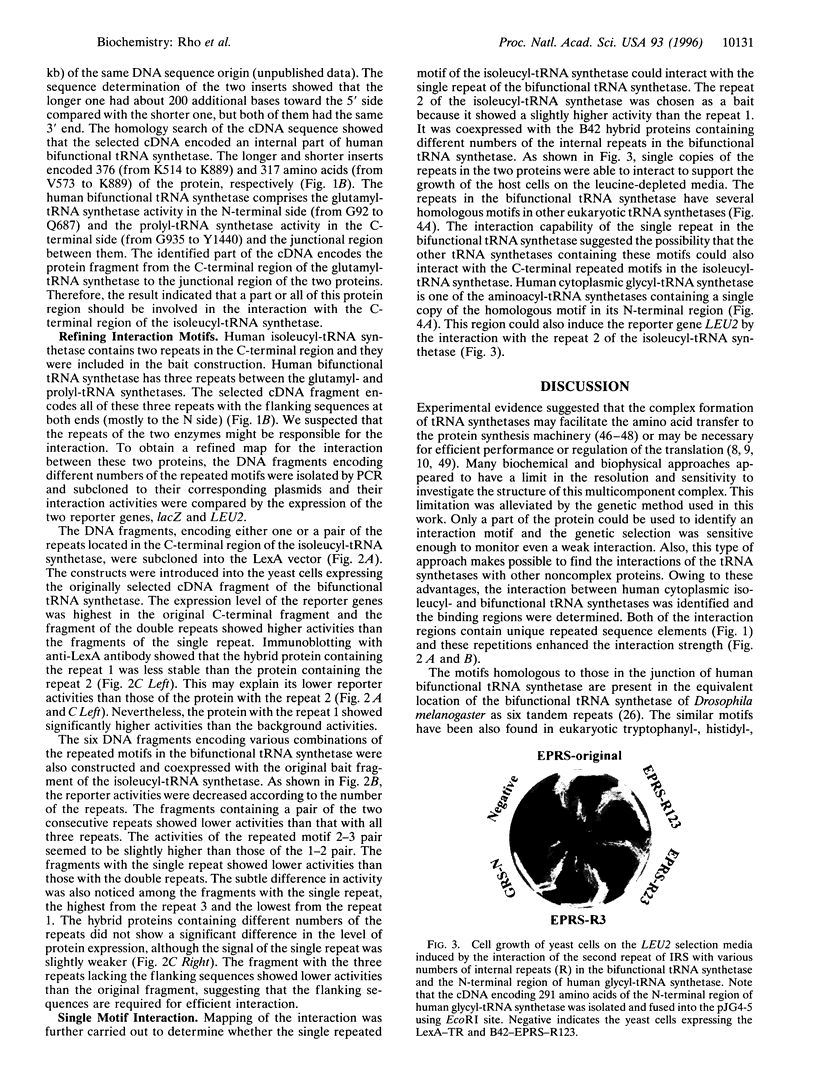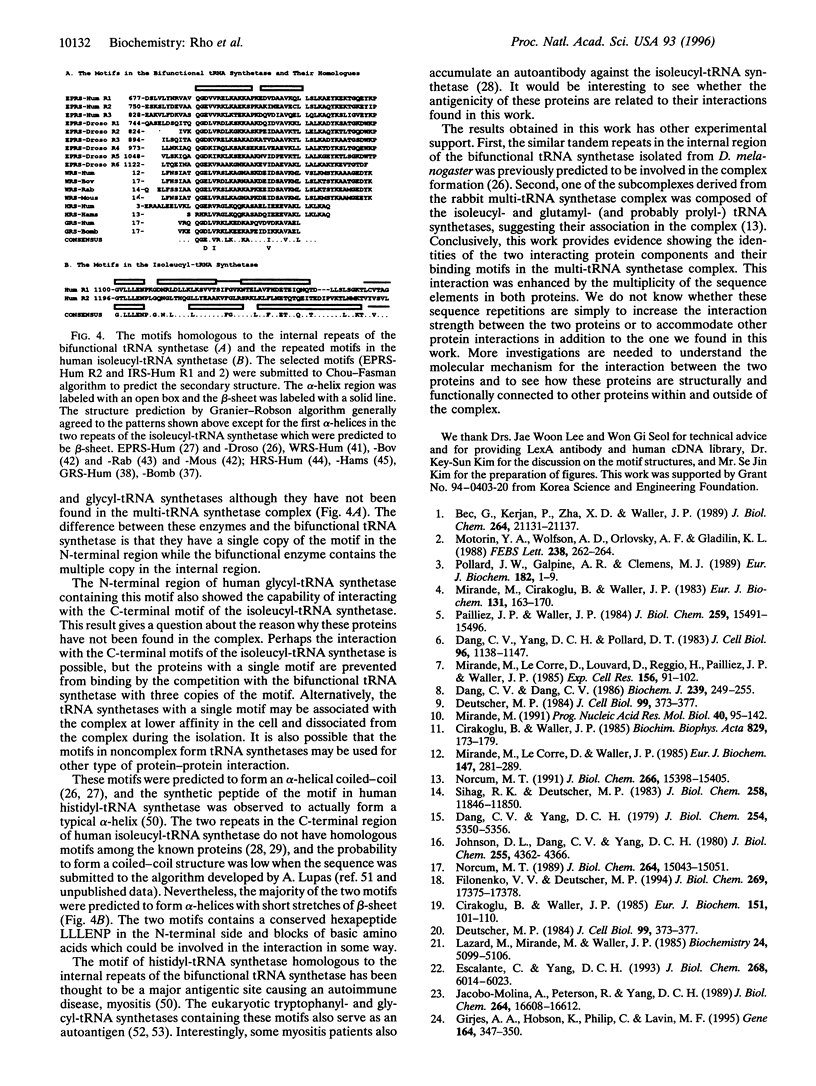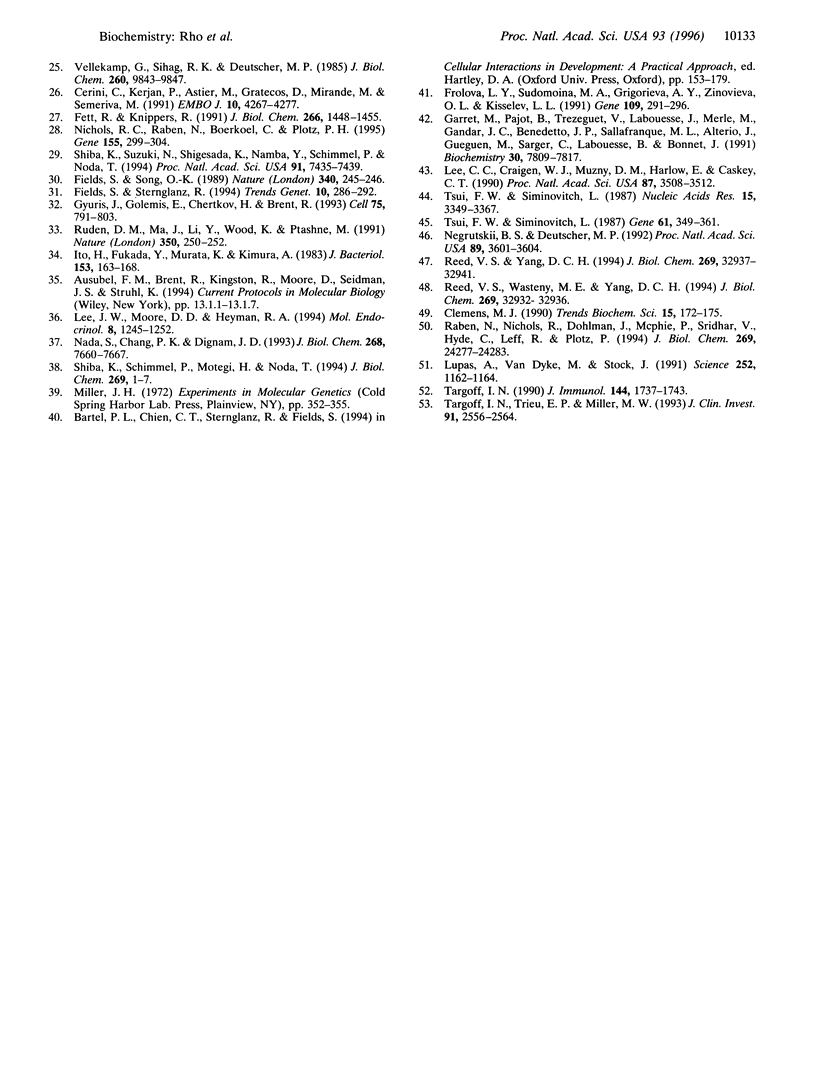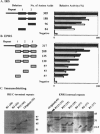Abstract
Aminoacyl-tRNA synthetases (tRNA synthetases) of higher eukaryotes form a multiprotein complex. Sequence elements that are responsible for the protein assembly were searched by using a yeast two-hybrid system. Human cytoplasmic isoleucyl-tRNA synthetase is a component of the multi-tRNA synthetase complex and it contains a unique C-terminal appendix. This part of the protein was used as bait to identify an interacting protein from a HeLa cDNA library. The selected sequence represented the internal 317 amino acids of human bifunctional (glutamyl- and prolyl-) tRNA synthetase, which is also known to be a component of the complex. Both the C-terminal appendix of the isoleucyl-tRNA synthetase and the internal region of bifunctional tRNA synthetase comprise repeating sequence units, two repeats of about 90 amino acids, and three repeats of 57 amino acids, respectively. Each repeated motif of the two proteins was responsible for the interaction, but the stronger interaction was shown by the native structures containing multiple motifs. Interestingly, the N-terminal extension of human glycyl-tRNA synthetase containing a single motif homologous to those in the bifunctional tRNA synthetase also interacted with the C-terminal motif of the isoleucyl-tRNA synthetase although the enzyme is not a component of the complex. The data indicate that the multiplicity of the binding motif in the tRNA synthetases is necessary for enhancing the interaction strength and may be one of the determining factors for the tRNA synthetases to be involved in the formation of the multi-tRNA synthetase complex.
Full text
PDF





Images in this article
Selected References
These references are in PubMed. This may not be the complete list of references from this article.
- Bec G., Kerjan P., Zha X. D., Waller J. P. Valyl-tRNA synthetase from rabbit liver. I. Purification as a heterotypic complex in association with elongation factor 1. J Biol Chem. 1989 Dec 15;264(35):21131–21137. [PubMed] [Google Scholar]
- Cerini C., Kerjan P., Astier M., Gratecos D., Mirande M., Sémériva M. A component of the multisynthetase complex is a multifunctional aminoacyl-tRNA synthetase. EMBO J. 1991 Dec;10(13):4267–4277. doi: 10.1002/j.1460-2075.1991.tb05005.x. [DOI] [PMC free article] [PubMed] [Google Scholar]
- Cirakoglu B., Waller J. P. Leucyl-tRNA and lysyl-tRNA synthetases, derived from the high-Mr complex of sheep liver, are hydrophobic proteins. Eur J Biochem. 1985 Aug 15;151(1):101–110. doi: 10.1111/j.1432-1033.1985.tb09074.x. [DOI] [PubMed] [Google Scholar]
- Cirakoğlu B., Waller J. P. Multiple forms of arginyl- and lysyl-tRNA synthetases in rat liver: a re-evaluation. Biochim Biophys Acta. 1985 Jun 10;829(2):173–179. doi: 10.1016/0167-4838(85)90186-4. [DOI] [PubMed] [Google Scholar]
- Clemens M. J. Does protein phosphorylation play a role in translational control by eukaryotic aminoacyl-tRNA synthetases? Trends Biochem Sci. 1990 May;15(5):172–175. doi: 10.1016/0968-0004(90)90153-3. [DOI] [PubMed] [Google Scholar]
- Dang C. V., Dang C. V. Multienzyme complex of aminoacyl-tRNA synthetases: an essence of being eukaryotic. Biochem J. 1986 Oct 15;239(2):249–255. doi: 10.1042/bj2390249. [DOI] [PMC free article] [PubMed] [Google Scholar]
- Dang C. V., Yang D. C., Pollard T. D. Association of methionyl-tRNA synthetase with detergent-insoluble components of the rough endoplasmic reticulum. J Cell Biol. 1983 Apr;96(4):1138–1147. doi: 10.1083/jcb.96.4.1138. [DOI] [PMC free article] [PubMed] [Google Scholar]
- Deutscher M. P. The eucaryotic aminoacyl-tRNA synthetase complex: suggestions for its structure and function. J Cell Biol. 1984 Aug;99(2):373–377. doi: 10.1083/jcb.99.2.373. [DOI] [PMC free article] [PubMed] [Google Scholar]
- Deutscher M. P. The eucaryotic aminoacyl-tRNA synthetase complex: suggestions for its structure and function. J Cell Biol. 1984 Aug;99(2):373–377. doi: 10.1083/jcb.99.2.373. [DOI] [PMC free article] [PubMed] [Google Scholar]
- Escalante C., Yang D. C. Expression of human aspartyl-tRNA synthetase in Escherichia coli. Functional analysis of the N-terminal putative amphiphilic helix. J Biol Chem. 1993 Mar 15;268(8):6014–6023. [PubMed] [Google Scholar]
- Fett R., Knippers R. The primary structure of human glutaminyl-tRNA synthetase. A highly conserved core, amino acid repeat regions, and homologies with translation elongation factors. J Biol Chem. 1991 Jan 25;266(3):1448–1455. [PubMed] [Google Scholar]
- Fields S., Song O. A novel genetic system to detect protein-protein interactions. Nature. 1989 Jul 20;340(6230):245–246. doi: 10.1038/340245a0. [DOI] [PubMed] [Google Scholar]
- Fields S., Sternglanz R. The two-hybrid system: an assay for protein-protein interactions. Trends Genet. 1994 Aug;10(8):286–292. doi: 10.1016/0168-9525(90)90012-u. [DOI] [PubMed] [Google Scholar]
- Filonenko V. V., Deutscher M. P. Evidence for similar structural organization of the multienzyme aminoacyl-tRNA synthetase complex in vivo and in vitro. J Biol Chem. 1994 Jul 1;269(26):17375–17378. [PubMed] [Google Scholar]
- Frolova LYu, Sudomoina M. A., Grigorieva AYu, Zinovieva O. L., Kisselev L. L. Cloning and nucleotide sequence of the structural gene encoding for human tryptophanyl-tRNA synthetase. Gene. 1991 Dec 30;109(2):291–296. doi: 10.1016/0378-1119(91)90624-k. [DOI] [PubMed] [Google Scholar]
- Garret M., Pajot B., Trézéguet V., Labouesse J., Merle M., Gandar J. C., Benedetto J. P., Sallafranque M. L., Alterio J., Gueguen M. A mammalian tryptophanyl-tRNA synthetase shows little homology to prokaryotic synthetases but near identity with mammalian peptide chain release factor. Biochemistry. 1991 Aug 6;30(31):7809–7817. doi: 10.1021/bi00245a021. [DOI] [PubMed] [Google Scholar]
- Girjes A. A., Hobson K., Chen P., Lavin M. F. Cloning and characterization of cDNA encoding a human arginyl-tRNA synthetase. Gene. 1995 Oct 27;164(2):347–350. doi: 10.1016/0378-1119(95)00502-w. [DOI] [PubMed] [Google Scholar]
- Gyuris J., Golemis E., Chertkov H., Brent R. Cdi1, a human G1 and S phase protein phosphatase that associates with Cdk2. Cell. 1993 Nov 19;75(4):791–803. doi: 10.1016/0092-8674(93)90498-f. [DOI] [PubMed] [Google Scholar]
- Ito H., Fukuda Y., Murata K., Kimura A. Transformation of intact yeast cells treated with alkali cations. J Bacteriol. 1983 Jan;153(1):163–168. doi: 10.1128/jb.153.1.163-168.1983. [DOI] [PMC free article] [PubMed] [Google Scholar]
- Jacobo-Molina A., Peterson R., Yang D. C. cDNA sequence, predicted primary structure, and evolving amphiphilic helix of human aspartyl-tRNA synthetase. J Biol Chem. 1989 Oct 5;264(28):16608–16612. [PubMed] [Google Scholar]
- Johnson D. L., Van Dang C., Yang D. C. Purification and characterization of lysyl-tRNA synthetase after dissociation of the particulate aminoacyl-tRNA synthetases from rat liver. J Biol Chem. 1980 May 10;255(9):4362–4366. [PubMed] [Google Scholar]
- Lazard M., Mirande M., Waller J. P. Purification and characterization of the isoleucyl-tRNA synthetase component from the high molecular weight complex of sheep liver: a hydrophobic metalloprotein. Biochemistry. 1985 Sep 10;24(19):5099–5106. doi: 10.1021/bi00340a021. [DOI] [PubMed] [Google Scholar]
- Lee C. C., Craigen W. J., Muzny D. M., Harlow E., Caskey C. T. Cloning and expression of a mammalian peptide chain release factor with sequence similarity to tryptophanyl-tRNA synthetases. Proc Natl Acad Sci U S A. 1990 May;87(9):3508–3512. doi: 10.1073/pnas.87.9.3508. [DOI] [PMC free article] [PubMed] [Google Scholar]
- Lee J. W., Moore D. D., Heyman R. A. A chimeric thyroid hormone receptor constitutively bound to DNA requires retinoid X receptor for hormone-dependent transcriptional activation in yeast. Mol Endocrinol. 1994 Sep;8(9):1245–1252. doi: 10.1210/mend.8.9.7838157. [DOI] [PubMed] [Google Scholar]
- Mirande M. Aminoacyl-tRNA synthetase family from prokaryotes and eukaryotes: structural domains and their implications. Prog Nucleic Acid Res Mol Biol. 1991;40:95–142. doi: 10.1016/s0079-6603(08)60840-5. [DOI] [PubMed] [Google Scholar]
- Mirande M., Cirakoğlu B., Waller J. P. Seven mammalian aminoacyl-tRNA synthetases associated within the same complex are functionally independent. Eur J Biochem. 1983 Mar 1;131(1):163–170. doi: 10.1111/j.1432-1033.1983.tb07244.x. [DOI] [PubMed] [Google Scholar]
- Mirande M., Le Corre D., Louvard D., Reggio H., Pailliez J. P., Waller J. P. Association of an aminoacyl-tRNA synthetase complex and of phenylalanyl-tRNA synthetase with the cytoskeletal framework fraction from mammalian cells. Exp Cell Res. 1985 Jan;156(1):91–102. doi: 10.1016/0014-4827(85)90264-2. [DOI] [PubMed] [Google Scholar]
- Mirande M., Le Corre D., Waller J. P. A complex from cultured Chinese hamster ovary cells containing nine aminoacyl-tRNA synthetases. Thermolabile leucyl-tRNA synthetase from the tsH1 mutant cell line is an integral component of this complex. Eur J Biochem. 1985 Mar 1;147(2):281–289. doi: 10.1111/j.1432-1033.1985.tb08748.x. [DOI] [PubMed] [Google Scholar]
- Motorin YuA, Wolfson A. D., Orlovsky A. F., Gladilin K. L. Mammalian valyl-tRNA synthetase forms a complex with the first elongation factor. FEBS Lett. 1988 Oct 10;238(2):262–264. doi: 10.1016/0014-5793(88)80492-7. [DOI] [PubMed] [Google Scholar]
- Nada S., Chang P. K., Dignam J. D. Primary structure of the gene for glycyl-tRNA synthetase from Bombyx mori. J Biol Chem. 1993 Apr 15;268(11):7660–7667. [PubMed] [Google Scholar]
- Negrutskii B. S., Deutscher M. P. A sequestered pool of aminoacyl-tRNA in mammalian cells. Proc Natl Acad Sci U S A. 1992 Apr 15;89(8):3601–3604. doi: 10.1073/pnas.89.8.3601. [DOI] [PMC free article] [PubMed] [Google Scholar]
- Nichols R. C., Raben N., Boerkoel C. F., Plotz P. H. Human isoleucyl-tRNA synthetase: sequence of the cDNA, alternative mRNA splicing, and the characteristics of an unusually long C-terminal extension. Gene. 1995 Apr 3;155(2):299–304. doi: 10.1016/0378-1119(94)00634-5. [DOI] [PubMed] [Google Scholar]
- Norcum M. T. Isolation and electron microscopic characterization of the high molecular mass aminoacyl-tRNA synthetase complex from murine erythroleukemia cells. J Biol Chem. 1989 Sep 5;264(25):15043–15051. [PubMed] [Google Scholar]
- Norcum M. T. Structural analysis of the high molecular mass aminoacyl-tRNA synthetase complex. Effects of neutral salts and detergents. J Biol Chem. 1991 Aug 15;266(23):15398–15405. [PubMed] [Google Scholar]
- Pailliez J. P., Waller J. P. Phenylalanyl-tRNA synthetases from sheep liver and yeast. Correlation between net charge and binding to ribosomes. J Biol Chem. 1984 Dec 25;259(24):15491–15496. [PubMed] [Google Scholar]
- Pollard J. W., Galpine A. R., Clemens M. J. A novel role for aminoacyl-tRNA synthetases in the regulation of polypeptide chain initiation. Eur J Biochem. 1989 Jun 1;182(1):1–9. doi: 10.1111/j.1432-1033.1989.tb14793.x. [DOI] [PubMed] [Google Scholar]
- Raben N., Nichols R., Dohlman J., McPhie P., Sridhar V., Hyde C., Leff R., Plotz P. A motif in human histidyl-tRNA synthetase which is shared among several aminoacyl-tRNA synthetases is a coiled-coil that is essential for enzymatic activity and contains the major autoantigenic epitope. J Biol Chem. 1994 Sep 30;269(39):24277–24283. [PubMed] [Google Scholar]
- Reed V. S., Wastney M. E., Yang D. C. Mechanisms of the transfer of aminoacyl-tRNA from aminoacyl-tRNA synthetase to the elongation factor 1 alpha. J Biol Chem. 1994 Dec 30;269(52):32932–32936. [PubMed] [Google Scholar]
- Reed V. S., Yang D. C. Characterization of a novel N-terminal peptide in human aspartyl-tRNA synthetase. Roles in the transfer of aminoacyl-tRNA from aminoacyl-tRNA synthetase to the elongation factor 1 alpha. J Biol Chem. 1994 Dec 30;269(52):32937–32941. [PubMed] [Google Scholar]
- Ruden D. M., Ma J., Li Y., Wood K., Ptashne M. Generating yeast transcriptional activators containing no yeast protein sequences. Nature. 1991 Mar 21;350(6315):250–252. doi: 10.1038/350250a0. [DOI] [PubMed] [Google Scholar]
- Shiba K., Suzuki N., Shigesada K., Namba Y., Schimmel P., Noda T. Human cytoplasmic isoleucyl-tRNA synthetase: selective divergence of the anticodon-binding domain and acquisition of a new structural unit. Proc Natl Acad Sci U S A. 1994 Aug 2;91(16):7435–7439. doi: 10.1073/pnas.91.16.7435. [DOI] [PMC free article] [PubMed] [Google Scholar]
- Sihag R. K., Deutscher M. P. Perturbation of the aminoacyl-tRNA synthetase complex by salts and detergents. Importance of hydrophobic interactions and possible involvement of lipids. J Biol Chem. 1983 Oct 10;258(19):11846–11850. [PubMed] [Google Scholar]
- Targoff I. N. Autoantibodies to aminoacyl-transfer RNA synthetases for isoleucine and glycine. Two additional synthetases are antigenic in myositis. J Immunol. 1990 Mar 1;144(5):1737–1743. [PubMed] [Google Scholar]
- Targoff I. N., Trieu E. P., Miller F. W. Reaction of anti-OJ autoantibodies with components of the multi-enzyme complex of aminoacyl-tRNA synthetases in addition to isoleucyl-tRNA synthetase. J Clin Invest. 1993 Jun;91(6):2556–2564. doi: 10.1172/JCI116493. [DOI] [PMC free article] [PubMed] [Google Scholar]
- Tsui F. W., Siminovitch L. Isolation, structure and expression of mammalian genes for histidyl-tRNA synthetase. Nucleic Acids Res. 1987 Apr 24;15(8):3349–3367. doi: 10.1093/nar/15.8.3349. [DOI] [PMC free article] [PubMed] [Google Scholar]
- Tsui F. W., Siminovitch L. Structural analysis of the 5' region of the chromosomal gene for hamster histidyl-tRNA synthetase. Gene. 1987;61(3):349–361. doi: 10.1016/0378-1119(87)90198-3. [DOI] [PubMed] [Google Scholar]
- Van Dang C., Yang D. C. Disassembly and gross structure of particulate aminoacyl-tRNA synthetases from rat liver. Isolation and the structural relationship of synthetase complexes. J Biol Chem. 1979 Jun 25;254(12):5350–5356. [PubMed] [Google Scholar]
- Vellekamp G., Sihag R. K., Deutscher M. P. Comparison of the complexed and free forms of rat liver arginyl-tRNA synthetase and origin of the free form. J Biol Chem. 1985 Aug 15;260(17):9843–9847. [PubMed] [Google Scholar]
- White M. F., Kahn C. R. The insulin signaling system. J Biol Chem. 1994 Jan 7;269(1):1–4. [PubMed] [Google Scholar]




